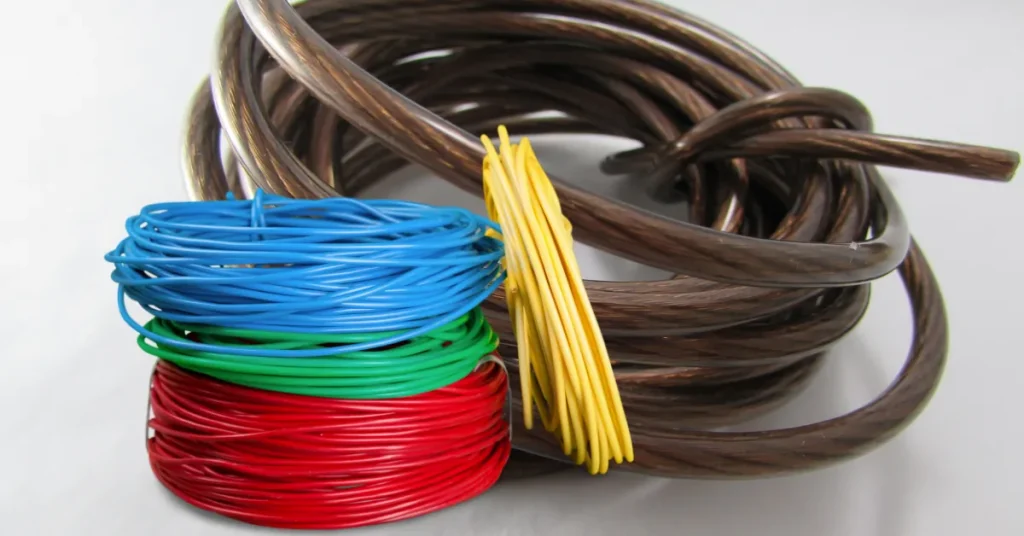A 4 gauge wire typically has a thickness of 0.2043 inches or 5.189 mm. Its diameter is essential for its electrical conductivity and current-carrying capacity.
Understanding the thickness of wire gages is crucial for electricians, engineers, and DIY enthusiasts working with electrical installations or projects.
The American Wire Gauge (AWG) system, widely used in North America, standardizes the sizes of round, solid, nonferrous, electrically conducting wire.
The smaller the gauge number, the thicker the wire. This makes a 4 gauge wire quite thick compared to higher-numbered gauges, enabling it to handle higher amounts of electrical current.
Selecting the appropriate wire gauge is vital for safety and efficiency in electrical systems, ensuring that the wire can accommodate the electrical load without overheating or causing a potential hazard.

The Intrigues Of Wire Gauging
The world of electrical wiring is intriguing. The thickness of wire plays a crucial role. Wire gauge is a term that might confuse many. Yet, it’s essential for safety and performance. Understanding wire gauge, such as the 4 gauge wire, is a journey into science and history.
Gauge Numbers And Their Significance
The gauge number of a wire reveals its thickness. Lower numbers mean thicker wires. A 4 gauge wire is thicker than a 10 gauge wire. This size affects how much current the wire can safely carry.
Thicker wires, like the 4 gauge, can carry more current. This is because they have less resistance to the flow of electricity.
| Gauge Number | Diameter (inches) | Diameter (mm) |
| 4 Gauge | 0.2043 | 5.189 |
| 10 Gauge | 0.1019 | 2.588 |
As the gauge number increases, the wire’s thickness decreases. Hence, a higher gauge number signifies a thinner wire.
Historical Origins Of Wire Gauge Measurements
Wire gauging has a rich history. It dates back to the 1700s. The methods used to measure wire then were far from standardized.
Many industries had their own way of measuring. This made it tough to compare wire sizes across different sectors.
- The Birmingham Gauge, also known as Stubs Iron Wire Gauge, was widely used in Britain.
- The American Wire Gauge (AWG), also known as Brown & Sharpe Gauge, became standard in the US.
Today, most countries use the AWG system. This helps everyone to understand the size of wires such as the 4 gauge wire easily.
Unveiling The 4 Gauge Wire
Understanding the 4 gauge wire is vital for professionals and DIY enthusiasts alike. This wire has a specific thickness and strength. It is a key player in heavy-duty applications. Let’s explore its size, characteristics, and uses.
Physical Attributes
Thickness matters in the electrical world, and the 4 gauge wire stands out. With a diameter of approximately 5.19 millimeters (0.2043 inches), it is robust and sturdy. Knowing its dimensions is crucial for safe and efficient use.
| Attribute | Value |
| Diameter | 5.19 mm / 0.2043 in |
| Area | 21.15 mm2 / 0.0328 in2 |
Typical Applications In Industry
The 4 gauge wire is a powerhouse in the industrial realm. It transmits power effectively where ample current is essential:
- Automotive: Powers engines and large vehicles.
- Audio systems: Connects amplifiers and subwoofers.
- Solar panels: Links panels to batteries.
- Marine applications: Ensures smooth sail with reliable electrical systems.
Its versatility makes it indispensable across various sectors. Properly gauging wire ensures safety and performance in these demanding settings.
Measurement Systems For Wire Thickness

Understanding wire thickness is vital in various industries and applications. The gauge of a wire refers to its diameter, which influences its current-carrying capacity and resistance.
Across the globe, multiple measurement systems exist, which can sometimes lead to confusion. Let’s explore the most common systems for measuring wire thickness.
Comparing Awg, Swg, And Other Systems
Wire thickness often gets measured in gauges and two primary systems exist: AWG (American Wire Gauge) and SWG (Standard Wire Gauge). While AWG is widely used in North America, other parts of the world, like the UK, commonly use SWG.
- AWG: Decreasing numbers indicate increasing thickness.
- SWG: Numbers work similarly to AWG but differ in actual size.
Other measurement systems include the metric system, where thickness is directly expressed in millimeters or centimeters.
Converting Between Different Gauge Standards
Converting between AWG and SWG can be a challenge. It’s crucial for precision in projects that require specific wire thickness for safety and functionality.
| AWG (inches) | SWG (inches) | AWG to SWG Conversion |
| 0.2043 | 0.220 | 4 AWG ≈ 6 SWG |
| 0.2320 (4 gauge) | 0.238 | 4 AWG ≈ 4 SWG |
It is important to note that a 4 gauge AWG wire has a diameter of 0.2320 inches, which corresponds closely to 4 SWG. To convert this accurately, one must use a specialized conversion chart or calculator.
For precision, tools like conversion calculators become indispensable. They help convert between different gauge standards easily.
By understanding and accurately converting these measurements, professionals can ensure the correct wire thickness for their specific needs.
Practical Insights Into Wire Usage
Practical Insights into Wire Usage: Understanding the intricacies of wire gauge can provide invaluable knowledge for numerous applications.
The thickness of a wire dictates its usage across various fields. Here, we dive into the common 4-gauge wire, revealing its properties particular to safety and efficiency.
Safety Factors In Electrical Applications
Never overlook safety with electrical wires. The correct wire thickness, like 4-gauge, ensures devices operate without risks. Choosing the wrong wire gauge can lead to overheating. It might even cause fires. Always follow electrical codes to pick the right wire size.
- Ampacity: 4-gauge wire carries a specific current load safely.
- Insulation: Proper insulation protects against environmental damage and electrical faults.
- Installation: Proper installation mitigates risks. It ensures cables do not strain under pressure.
Effect Of Wire Thickness On Conductivity And Resistance
Thicker wires, like the 4-gauge, come with lower resistance. They allow better conductivity. This enables more current to flow with less heat generation.
| Wire Gauge | Thickness (in) | Conductivity | Resistance |
| 4 Gauge | 0.2043 | High | Low |
| 6 Gauge | 0.1620 | Medium | Higher |
| 8 Gauge | 0.1285 | Lower | High |
In summary, 4-gauge wire offers excellent electrical performance with its thickness. This equals safety and efficiency in high-power scenarios.
Buying Guide For 4 Gauge Wire

Welcome to the ultimate guide for finding the perfect 4 gauge wire for your needs. This section will cover key aspects to consider before making your purchase.
What To Look For In Quality Wire
Quality matters when it comes to 4 gauge wire. Here’s what to focus on:
- Conductor material: Copper is top-notch, offering great conductivity.
- Flexibility: A flexible wire makes installations easier.
- Insulation: Look for durable insulation to resist heat, oil, and wear.
Ensuring these features are present means your wire will last and perform well.
Deciphering The Labeling On Wire Packaging
Labels on wire packaging can be complex. Understanding them is key for the right purchase:
| Label Part | Meaning |
| AWG | Stands for “American Wire Gauge” – the size of the wire. |
| Voltage rating | Indicates the maximum voltage it can safely handle. |
| Temperature rating | Shows the range of temperatures the wire can withstand. |
Always check these details to ensure the wire meets your project’s requirements.
FAQs About How Thick Is 4 Gauge Wire
What Diameter Is 4 Gauge Wire?
A 4 gauge wire typically has a diameter of 0. 2043 inches or 5. 189 mm.
How Thick Is 4 Gauge Wire Fence?
A 4 gauge wire fence is approximately 0. 2043 inches or 5. 19 millimeters thick.
How Thick Is 4 Gauge Steel Wire?
A 4 gauge steel wire is approximately 0. 2043 inches or 5. 189 millimeters thick.
How Many Amps Is A 4 Gauge Wire?
A 4 gauge wire can carry approximately 70 to 85 amps, depending on the insulation type and the ambient temperature conditions.
Conclusion
Understanding 4 gauge wire thickness is crucial for safe electrical practices. This post confirmed it’s approximately 0. 2043 inches or 5. 189 mm.
Remember these measurements for your next project. It ensures safety, efficiency, and compliance with industry standards. Summit your electrical endeavors with confidence, using the right wire for the job.
Resources:
1. https://efotg.sc.egov.usda.gov/references/Delete/2011-8-27/382fenceCSpermanentElectricHighTensiles.pdf
